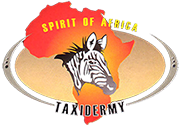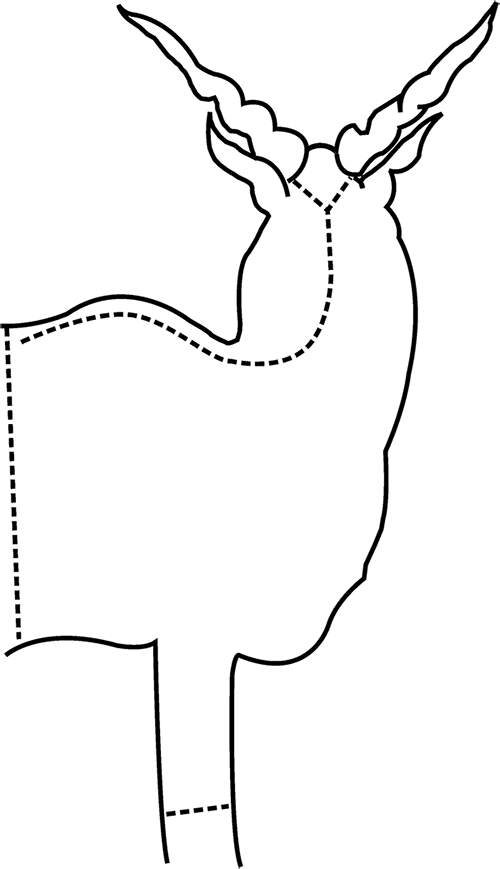Skinning & Field Care
INSTRUCTIONS FOR PROPER FIELD CARE & CAPING FOR TAXIDERMY
It is important for hunters to become familiar with proper capping procedures. Correct caping will allow the hunter extra time on the safari as the cape will be prepared & preserved straight away.
- Use correct caliber.
Far too often we have to spend countless hours repairing large bullet holes, which can look unsightly on a finished mount. African game having little hair is very hard to patch without leaving scarring. - Do not cut the throat or stab the trophy. Just shoot it once more (not in the head).
- As soon as possible, after your trophy has died, take it to a cool place to be processed. A large tree will do. Do not drag it, as this will tear hair from the skin. Carry or use a tarpaulin to drag to spot.
- Decide whether your trophy is going to be a shoulder mount or life size mount.
- Securing the animal to be caped.
Tie a rope to the horns, keeping the head as straight as possible, secure rope to branch or gantry & lift the animal off the ground. Use your 4 x 4 to lift a large animal if you are on your own.
It is now easy to gut the animal and to proceed with skinning or caping.
Alternately, you can lay the animal on its belly using the legs to stabilize it. Have someone hold the head & neck straight.
CAPING FOR A SHOULDER MOUNT (excluding warthog & bush pigs)
The neck of the animal must be stretched & straight-this will allow you to make a nice, clean straight cut down the back of the neck.
- Starting from behind each horn, cut a V-shape incision approximately 3 cm long.
- From the end of your V-cut, carry on cutting down the centre until you get to the halfway point of the body.
- Now cut around the circumference of the body. You can now start removing the skin (cape) from the animal.
- When you reach the leg area, cut the legs off at the knee & sock them out. Carry on skinning until you reach the back of the skull.
- Cut through the neck muscles & remove the body with neck muscles attached.
- Place the head on a flat, clean surface. You can now remove the rest of the skin from the skull. This procedure is very important & must be done with great care. An inexperienced person can ruin a trophy!
- Using a very sharp knife, skin around horn bases, being very careful not to cut the hair. As you move along you will come to the ear bases. Cut through the ear butts as close to the skull as you can.(Taxidermists need the ear butts intact). Keep moving forward until you get to the eyes. Place your pointer finger into the eye & push it back against the inner eyelid. This will allow you to cut through the eye without making a hole in this very delicate area. After both eyes are done continue towards the nose. You can now cut through the flesh that is the back corner of the cheek that leads to the inside of the mouth. Place your finger into this hole and pull back, cutting against the skull. This will remove the inner lips from the skull. Do this until you reach the nose.
- At this point there is a piece of cartilage between the skull & end of nose. You have to cut through this cartilage about midway to remove the face.
- Now you are ready for the delicate part of the operation, again using a very sharp knife, you can split the lips, nose, eyes & turn or invert the ears. Splitting the lips, nose & eyes means separating the 2 layers of skin (inner &outer). Turning or inverting the ears means separating inner & outer skin. The reason for this is to allow the salt to penetrate this area. (This procedure should be witnessed first before attempting to do it).
- After all the above is done you should remove all excess meat &fat. Salt the skin using a fine, uniodised salt, which is the best. Cover the cape liberally, rubbing the salt into the skin. The best place to do this is in a dry, cool place & not a damp salt room. Remember ventilation is important.
- If possible, Capes should be slightly elevated to allow the unbound fluid to drain.
- Leave salted for 12 hours or until there is no fluid coming out. Shake off and re-salt. Capes can be folded with hair to the inside when nearly dry. Store somewhere safe &dry.
- The skull can have all excess meat removed including jaw & brain. The skull can also be salted. Do not cut the horns from the skull. A good taxidermist will use the skull for reference.
SMALL GAME, BIRDS & FISH
- These are to be left whole & not gutted.
- When the animal has cooled down, place in a plastic bag and make sure all air is removed from the bag. Freeze.
- Do not leave in freezer for too long before delivering to your taxidermist as freezer burn can occur. Taxidermists can take steps to prevent this.
DOWNLOADS
What to do!
- Always use a sharp, clean knife.
- Make all incisions clean & straight
- Skin & salt a.s.a.p.
- Always use clean, fine, uniodised salt.
- Make sure all trophies are tagged.
- Store cape somwhere dry & safe. Rats & mice like eating this tasty marterial.
- Make sure that if someone else is going to cape your trophy, they know what they are doing.
- Try & supervise the caping procedures to make sure it is done properly.
- If you cannot salt or cape a skin it can be frozen in a plastic bag.
- Excess blood can be wiped off with a wet rag.
- Remove all excess meat & fat
- Freeze all amall mammals, birds & fish. Do not gut them.
- It is advisble to get your trophy to your taxidermist a.s.a.p.
What not to do!
- Never place salted, dry skins, capes in a plastic bag.
- Never air dry capes or skins.
- Never leave salted capes , skins in the sun or where dogs or preditors can get them.
- Never use rock salt.
- Never use old salt.
- Never salt & stack another skin or cape on top of one another.
- Don’t salt & freeze trophies.
- Don’t put skins into salt brines or disinfected solutions.
- Don’t leave capes unsalted in coolrooms.
- Don’t drag trophies on the ground.
- Don’t cut through the hair.
- Don’t use blunt knives.
- Don’t cut the skulls.
- Don’t stab or cut the throat.
- Don’t use cutting method on warthog or bushpig, they can be socked out.

